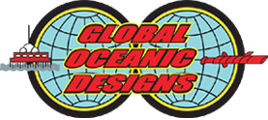SeaDog Systems, Inc.
Prototypes & Prototype Testing Over Nearly a Decade
The prototype testing conducted at Texas A&M University’s Offshore Technology Research Center (OTRC) wave pool confirmed that the SeaDog Wave Pump had practical uses and justified ocean trials. The second SeaDog Wave Pump, a one-fifth scale prototype was designed, built and placed off the east jetty in the Gulf of Mexico south of Freeport, Texas. As one of the largest ports in the country, the surrounding community paid attention as Mr. Welch and his crew dared the elements to take daily measurements and inspect the instrumentation.
The second one-fifth scale SeaDog Wave Pump performed continuously for 32 days providing a magnificent glimpse into the future of wave technology. In fact, the testing culminated in the first “bucket test” in a natural environment. A jack-up boat was rented, and Mr. Welch and the development team were overflowing with excitement. Ironically, the seas quieted to six inches of wave height during the 48-hour window in which this testing could occur.
Remarkably, the second one-fifth scale SeaDog Wave Pump functioned well despite the lack of stroke length for the pistons due to the minimal wave height. Nevertheless, it pumped seawater up the 3-inch flex line to fill the 55-gallon drum hanging 118 feet above water level to the amazement of the jack-up boat crew. The captain proclaimed that the 60-foot vessel did not hold a diesel or electric pump capable of such a feat.
As an added visual display for future plans of the SeaDog, the water was released from the suspended drum through the line to a Pelton-wheel turbine on the deck of the jack-up boat suspended 90 feet above the waves. Water splashed as the micro hydro-turbine converted the energy into usable electricity to light the first light bulbs by the SeaDog Wave Pump, using ocean waves.
There was no notable environmental impact, prediction of large-scale SeaDog installations came back with positive reports such as the creation of artificial reef structures that provide breeding grounds for a variety of local species of marine life.
The media drum had begun to beat as national networks started to run the SeaDog Pump story. Articles appeared in notable publications such as Popular Mechanics, Ocean Engineering Magazine, and the Houston Chronicle. Television programs such as Fox News would not be left out of the mix, and an entire circuit of radio interview requests from organizations such as WCCO in Minneapolis, Minnesota flooded the representatives of the SeaDog.
The third SeaDog Wave Pump prototype at one-fifth scale was developed and deployed in the Gulf of Mexico one half mile south of Galveston, Texas for formal third party testing in a real-world ocean environment. Dr. Frank Warnakulasuriya of Texas A&M University – Galveston was chosen to lead the independent study of the second ocean trial. He and his team attached a number of sensors and monitors to record pressures achieved and volumes of water pumped.
[wds id=”2″]
Mr. Welch was given permission to place the upgraded version of the SeaDog Wave Pump one thousand feet off the historic Galveston Pier. It shot water up into the air through a one-way check valve with the passing of every wave and drew the curiosity of everyone along the beach.
The SeaDog Wave Pump was the talk of the town during its 90-day, third-party sea trial testing/demonstration. By the end of that summer, the testing crew enjoyed much attention from the community. The group was known for a collective “SeaDog” cry that would often be bellowed before leaving a local establishment. Restaurant and bar patrons would almost always respond in kind to show support and have some fun with Mr. Welch and the crew.
After its successful deployment, testing and demonstration, the SeaDog Wave Pump prototype was proudly displayed for over six months next to the hotel marque in the parking lot of the Hotel Galvez as a commercial-ready alternative to fossil fuels.
When the 90 day ocean trial was complete, Dr. Warnakulasuriya and Texas A&M University – Galveston fully endorsed the SeaDog as the most efficient wave- energy converter/pump. Using the same methodology, it can be concluded that the SeaDog Wave Pump is equally capable of pumping both liquids and gases at nearly any volume and pressure to be connected to end-user applications.
Such applications could include a turbine for electrical generation, a reverse-osmosis membrane for water desalination or a series of long-distance fluid lines or aqueducts to be powered and fed by the incremental push generated by the waves flowing through the SeaDog Wave Pump.
SeaDog Systems, Inc. has identified a vast array of applications for the SeaDog Wave Pump, Fulcrum Wave Pump and Fulcrum Pond Pounders, along with its Artificial Head Systems ranging from low to high pressure fluid pumping, hydroelectric grid energy production, saltwater desalination, irrigation and drainage systems along with many others valuable applications.
